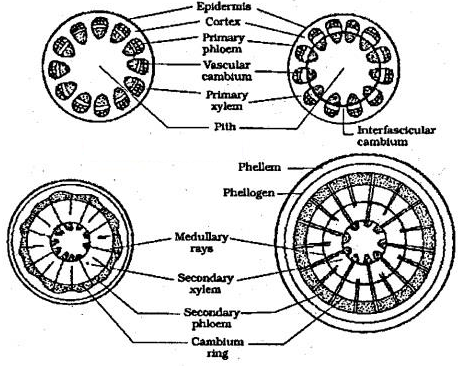The growth of roofs and stems in length with the help of apical meristem is called the primary growth. Most dicotyledonous plants exhibit an increase in girth. This increase is called secondary growth. The tissues involved in secondary growth are the two lateral meristems.
(a) Vascular cambium:
The meristematic layer responsible for cutting vascular tissues- xylem and phloem is called vascular cambium. In dicot stems, the cells of cambium present between primary xylem and primary phloem is the intrafascicular cambium. The medullary cells adjoining these form intrafascicular cambium. Thus a continuous ring of cambium is formed. Activity of the cambial ring. The cambial ring becomes active and begins to cut new cells, both towards the inner and the outer sides.
The cells cut towards pith, mature into secondary xylem and the cells cut towards periphery, mature in secondary phloem. The cambium is generally more active on the inner side than on the outer. As a result, the amount of secondary xylem produced is more than secondary phloem and soon forms a compact mass.
The primary and secondary phloems get gradually crushed due to the continued formation and accumulation of secondary xylem. At some places, the cambium forms a narrow band of parenchyma, which passes through the secondary xylem and the secondary phloem in radial directions. These are called medullary rays.

(b) Cork cambium:
As the stem continues to increase in girth due to the activity of vascular cambium, the outer cortical arid epidermis layers get broken and need to be replaced to provide new protective cell layers. Hence, another meristematic tissue called cork cambium or phellogen develops, usually in the cortex region. Phellogen is a couple of layers thick. It is made of narrow, thin-walled and nearly rectangular cells. Phellogen cuts *** cells on both sides. The outer cells differentiate into cork while the inner cell differentiates into the secondary cortex. The cork is impervious to water due to suberin deposition in the cell wall.
The cells of the secondary cortex are parenchymatous. Phellogen, phellem and phelloderm are collectively known as periderm. Due to the activity of cork cambium, pressure builds up on the remaining layers peripheral to phellogen and ultimately these layers and slough .
At certain regions, the phellogen cuts *** closely arranged parenchymatous cells on the outer side instead of cork cell. These parenchymous cells soon rupture the epidermis, forming a lens-shaped openings called lenticels. Lenticels permit the exchange of gases between the outer atmosphere and the internal tissue of the stem.